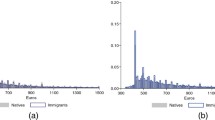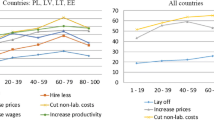Abstract
This note shows that the models estimated in Babecký et al. (Scand J Econ 112(4):884–910, 2010) do not allow identifying the determinants of downward nominal wage rigidity and provides new empirical evidence on the importance of downward nominal wage rigidity and its determinants in several European countries.
Similar content being viewed by others
Notes
In rigour, the authors estimate a bivariate probit model to account for the interdependence between their measures of DNWR and DRWR which are investigated together in their paper. This, however, is not relevant for the point made in this note which concerns the sample used and not the type of model estimated. Moreover, as we shall show below, the empirical results are basically the same when a univariate or a bivariate model is used.
As in Babecký et al. (2010), in this note the union coverage is computed as the proportion of workers in the firm covered by collective wage agreements. In rigour, however, for each firm, the union coverage should be defined as the proportion of workers covered by collective wage agreements out of those scheduled for a wage cut. This limitation stemming from the lack of appropriate data may be expected to have implications for the parameters of the models estimated below. For a discussion, see Dias et al. (2012).
Our dataset matches closely the one used in Babecký et al. (2010), though they differ in some respects. Ours is an updated version of the original dataset, whose major difference is the inclusion of Cyprus, which was not available to be used in Babecký et al. (2010), and the exclusion of Greece, because the survey conducted in this country has no information on base-wage cuts, which is a variable of interest for us. We also excluded the firms that have not answered one of the two questions on wage freezes or wage cuts. The final set of countries includes Austria, Belgium, Cyprus, Czech Republic, Estonia, France, Hungary, Ireland, Italy, Lithuania, Netherlands, Poland, Portugal, Slovenia and Spain. For further details on the design of the survey, see Druant et al. (2009) or Babecký et al. (2010).
Some of our figures on the incidence of wage freezes differ from the ones presented in Babecký et al. (2010). We believe that the main source of divergence stems from the fact that figures in Babecký et al. (2010) are employment-weighted, while our figures in Table 1 are not. The fact that we are using a slightly different sample may also help explaining the differences.
Note that the estimates of DNWR are based on firm-level data and not on worker-level data, i.e. it is implicitly assumed that all the workers in the firms involved are scheduled for a wage cut, regardless of the share of workers covered by the wage cuts or freezes. Moreover, because they are based on dnwr1, i.e. do not exclude the workers whose wages would have been frozen in the absence of DNWR, they are likely to overestimate the importance of DNWR.
For a review of the literature underlying such regressors, see Babecký et al. (2010).
The four regressions include country dummies to account for fixed effects whose estimated coefficients are not reported in Table 2. These country dummies enable us to control for variations in any country-specific omitted factor, such as differences in the survey design across countries, different degrees of employment protection legislation, different inflation rates, etc.
In the survey about 0.7 % of the firms answered that they had both frozen and cut wages over the last 5 years. For estimation purposes, we assumed that wages in such firms are flexible, so that they enter in the estimated probit models with \(y_{i}=0\).
It is well known that the estimators of the parameters in probit or logit models are biased in finite samples. Moreover, King and Zeng (2001) show that these biases become especially acute and the conventional variance estimators significantly magnified in the presence of rare events, i.e. when Prob(\(y_{i}=1\)) (or Prob(\(y_{i}=0\))) is very small. In our case, the small proportion of wage cuts in the population of firms whose workers were scheduled for a wage cut (around 20 %), is likely also to make it more difficult to get unbiased and statistically significant coefficients for the parameters of the model.
References
Altonji JG, Devereux PJ (2000) The extent and consequences of downward nominal wage rigidity. In: Worker well-being, vol 19. Elsevier, Amsterdam, pp 383–431
Babecký J, Caju PD, Kosma T, Lawless M, Messina J, Room T (2010) Downward nominal and real wage rigidity: survey evidence from European firms. Scand J Econ 112(4):884–910
Caju PD, Fuss C, Wintr L (2007) Downward wage rigidity for different workers and firms: an evaluation for belgium using the IWFP procedure. Working Paper Series 840, European Central Bank
Caju PD, Fuss C, Wintr L (2009) Understanding sectoral differences in donward real wage rigidity: workforce composition, institutions, tecnology and competition. Working Paper Series 1006, European Central Bank
Card D, Hyslop D (1997) Does inflation “grease the wheels of the labor market”? In: Romer CD, Romer DH (eds) Reducing inflation: motivation and strategy. University of Chicago Press, Chicago
Dias D, Marques CR, Martins F (2012) Identifying the determinants of downward wage rigidity: Some methodological considerations and new empirical evidence. Working Paper Series 15, Banco de Portugal
Dickens WT, Goette L (2006) Estimating wage rigidity for the international wage flexibility project. Mimeo, Brookings Institution
Dickens WT, Goette L, Groshen EL, Holden S, Messina J, Schweitzer ME, Turunen J, Ward ME (2007) How wages change: micro evidence from the International Wage Flexibility Project. J Econ Perspect 21(2):195–214
Druant M, Fabiani S, Kezdi G, Lamo A, Martins F, Sabbatini R (2009) How are firms’ wages and prices linked: survey evidence in Europe. Working Paper Series 1084, European Central Bank
Fehr E, Goette L (2005) Robustness and real consequences of nominal wage rigidity. J Monet Econ 52(4):779–804
Goette L, Sunde U, Bauer T (2007) Wage rigidity: measurement, causes and consequences. Econ J 117(524):F499–F507
Holden S (2004) The costs of price stability: downward nominal wage rigidity in Europe. Economica 71:183–208
Holden S, Wulfsberg F (2008) Downward nominal wage rigidity in the OECD. BE J Macroecon 8(1):(Advances), Article 15
Kahn S (1997) Evidence of nominal wage stickiness from microdata. Am Econ Rev 87(5):993–1008
King G, Zeng L (2001) Logistic regression in rare events data. Polit Anal 9(2):137–163
Knoppik C, Beissinger T (2009) Downward nominal wage rigidity in Europe: an analysis of European micro data from the ECHP 1994–2001. Empir Econ 36(2):321–338
Messina J, Duarte CF, Izquierdo M, Caju PD, Hansen NL (2010) The incidence of nominal and real wage rigidity: an individual-based sectoral approach. J Eur Econ Assoc 8(2–3):487–496
Acknowledgments
The authors would like to thank Claudia Duarte and Pedro Portugal for helpful discussions and useful suggestions.
Author information
Authors and Affiliations
Corresponding author
Additional information
The views expressed in this paper are those of the authors and do not necessarily reflect those of the Banco de Portugal or the Eurosystem.
Appendix: Variable definitions
Appendix: Variable definitions
In this appendix, we describe the covariates used in the probit models whose results are presented in Sect. 4. The details are as follows:
-
Low-skilled blue-collar—Proportion of low-skilled blue-collar workers on firm’s total employment.
-
High-skilled blue-collar—Proportion of high-skilled blue-collar workers on firm’s total employment.
-
Low-skilled white-collar—Proportion of low-skilled white-collar workers on firm’s total employment.
-
Labour cost share—Proportion of labour costs on total costs.
-
Permanent workers—Proportion of workers with permanent contracts on the firm’s total workforce.
-
Only firm-level agreement—Dummy variable which equals 1 if the firm applies only an agreement concluded inside the firm.
-
Only outside agreement—Dummy variable which equals 1 if the firm applies only an agreement concluded outside the firm.
-
Both agreements—Dummy variable which equals 1 if the firm applies both firm-level and outside wage agreements.
-
Coverage—Proportion or workers covered by collective wage agreements.
-
Tenure 1–5 years—Proportion of workers with tenure between 1 and 5 years.
-
Tenure above 5 years—Proportion of workers with tenure above 5 years.
-
High competition—Dummy variable equal to one if the firm answers in the survey that it will likely or very likely decrease its price in reaction to a decrease in the price of its main competitor.
-
Size = 20–49—Dummy variable equal to one if the number of employees is between 20 and 49.
-
Size = 50–199—Dummy variable equal to one if the number of employees is between 50 and 199.
-
Size = 200+—Dummy variable equal to one if the number of employees is equal or larger than 200.
-
Construction—Dummy variable equal to one if the firm operates in the Construction sector.
-
Trade—Dummy variable equal to one if the firm operates in the Trade sector.
-
Other services—Dummy variable equal to one if the firm operates in any other sector.
Rights and permissions
About this article
Cite this article
Dias, D.A., Marques, C.R. & Martins, F. A replication note on downward nominal and real wage rigidity: survey evidence from European firms. Empir Econ 49, 1143–1152 (2015). https://doi.org/10.1007/s00181-014-0902-y
Received:
Accepted:
Published:
Issue Date:
DOI: https://doi.org/10.1007/s00181-014-0902-y




